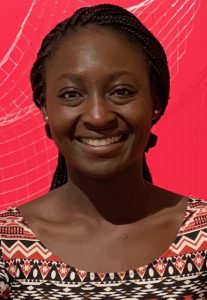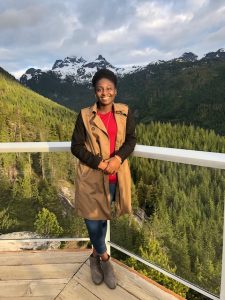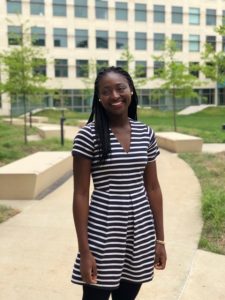Amazon began as an online book retailer in 1994, but now has a branch in every business sector imaginable. The professional opportunities at the organization are boundless, as Tolu Alabi, Stanford GSB MBA ’17 and Senior Technical Product Manager, knows well. In this edition of Real Humans: Alumni, Alabi recounts her journey of self-reflection and b-school student life to landing at the company. Read on to learn more about Amazon’s culture, the valuable skills of graduate management education, and how the MBA community carries on after graduation and more.

Tolu Alabi, Stanford GSB MBA ’17, Sr. Technical Product Manager
Age: 28 years
Hometown: Abuja, Nigeria
Undergraduate Institution and Major: Grinnell College – Double Major in Computer Science and Mathematics.
Graduate Business School, Graduation Year, and Concentration: Stanford Graduate School of Business (GSB) – Class of 2017 – General Management.
Pre-MBA Work Experience: Goldman Sachs & Co. – 2 years – Quantitative Developer (Quant).
Post-MBA Work Experience: Amazon – 2.5 years – Senior Technical Product Manager.
Why did you choose to attend business school?
While I was at Goldman, I enjoyed being a Quant developer. Solving programming challenges and building new software for the trading business gave me a sense of thrill and fulfillment, which was in line with the feelings I got while majoring in CS and math in college. However, as I approached my second year at Goldman, I began to seek more responsibility. I didn’t just want to build technical solutions, I also wanted to understand what the business and user problems were, figure out what technical solution would solve them, and then build the solution.
I wanted to take a problem from 0 to 1, from identification to ideation to solution. Despite this want for my career, I just couldn’t see myself getting there without adding more skills and knowledge to my arsenal. I had the technical chops, but the business, strategic, and operational knowledge were all missing. I had to conduct this check-in and be honest with myself about my gaps, because I wanted to fill those gaps and put myself in a better position to take problems from 0 to 1 successfully.
I figured I needed another degree, and I was initially going to do a Masters in Financial Engineering because it was closely related to my Quant job at Goldman at the time, but after talking to people and doing more research, I learned that an MBA was what I was looking for. I saw the MBA as an avenue to learn a ton about solving problems and building a business.
I knew I could always take Coursera classes to learn strategy, but to me the MBA was a great investment filled with the opportunity to learn from very accomplished professors, lecturers, and classmates. For me, taking 2 years off work to be surrounded by very high achieving people, who had done incredible things that I could learn from, was the perfect situation. My career goal was to leverage technology to solve real world problems, and the best avenue I saw to get the skills, knowledge, learning, and network to support that goal was through business school.
Why Stanford GSB? What factors figured most prominently into your decision of where to attend?
Three major factors contributed to my decision to attend the GSB. First and most importantly, Stanford seemed like the best place to achieve my goals in tech. I wanted to be surrounded by technology and innovative thinkers, for inspiration and my learning, and Stanford GSB seemed like the perfect place to meet this need due to its location in Silicon Valley.
Secondly, I wanted a school that cared about building a strong community amongst its students. I didn’t just want to go to business school to learn strategy or finance; instead, I wanted to be surrounded by great people who yearn to make an impact in the world, and I wanted to build lasting relationships with them. Stanford GSB has a stereotype of being a “touchy-feely” school where students like to talk about their feelings. Well, that happens to be my jam. I love connecting with people on a deep level and sharing real experiences together. In this regard, it felt like my and Stanford’s match was made in heaven.
In addition to my search for continuous learning on tech leadership and for building lasting relationships, the third factor that made the GSB a no-brainer was the weather. I wanted sunshine! I had lived in Iowa, Salt Lake City, NYC, and just wanted some palm trees and sun in December. I must say, I had all these dreams and check-boxes while applying to business schools, but when I actually got into Stanford GSB, it was truly amazing to see the dreams and check-boxes become a reality.
What about your MBA experience prepared you for your current career?
Two major factors that led me to the GSB in the first place really came through for me while I was there and now post the GSB. Firstly, learning from successful tech leaders through case studies. While at the GSB, I made sure to take as many tech and entrepreneurship classes as I could fit into my schedule. Some highlight classes in this bucket include (i) “Industrialist Dilemma” taught by Rob Siegel and Aaron Levie of Box, (ii) “Product Management” taught by Rob Siegel, and (iii) “Aligning Startups with Their Market” taught by Andy Rachleff.
Through these classes, I got to hear from a bunch of amazing people doing amazing things, for example, Aaron Levie, Anne Wojcicki, Patrick Collison, Tony Xu, Brian Chesky, and many more. I got to learn how startups successfully disrupt incumbents and how successful incumbents continually innovate to stay relevant and useful to consumers.

I know these classes don’t suddenly turn one into a tech tycoon overnight, but these classes lite a fire in me to continue to work hard and learn, because I too could someday build something cool and useful to humanity. Now as a project manager (PM) at Amazon, I carry this inspiration and the learnings from successful entrepreneurs before me, to inform my decision making at the ideation, design, and execution stage of the products I own.
The second major takeaway from the GSB that prepared me for life as a PM was all the education on interpersonal dynamics. I cannot overstate how critical it is to be able to communicate effectively and connect with people you work with. As a PM, a huge part of my job is working with people I don’t manage and ensuring they can do things for me. While working with sales, UX designers, developers, and data analysts, I have to collaborate a lot to get stuff done.
A big part of collaboration when you don’t manage the collaborators is keyed on getting them excited about your idea and vision, enough to fully invest their time and brain power to drive ts success. These are skills we learn at the GSB through classes and role plays. A couple classes come to mind for interpersonal dynamics – Touchy Feely (actually called “Interpersonal Dynamics”), “Negotiations,” and “Managing Growing Enterprises” (aka MGE). These classes presented valuable case studies on the importance of building a good working environment in order to achieve success.
As a PM, I strive to get my team excited about what we’re working on to help unlock bright ideas and solutions, and I also ensure to give kudos and make sure they feel seen for all their good work.
What was your internship during business school? How did that inform your post-MBA career choice?
I interned at WhatsApp as a growth analyst, mostly doing strategy and some partnerships. My idea with going after this role was more exploratory, to try a non-tech role to see if I would enjoy it. I love tech too much so I still stayed within a tech company, but I was completely on the business side during my internship. Interestingly, I didn’t enjoy the role.

I had a blast at WhatsApp and Facebook, but I really missed building. The only thing I built during my internship was a bunch of slides and graphs, which were good learnings for me, but I terribly missed building for end-users. This internship informed me that I enjoy being at a tech company, but I also need to be building for end-users. As a result, after the internship, I began to look exclusively at product management opportunities for my full-time job.
Why did you choose your current company? What factors figured most prominently into your decision of where to work?
Three factors influenced my decision to choose Amazon: (i) I wanted to maximize my learning opportunity. Although I was previously a software developer, I had never been a PM, so I wanted to be at a company where I could learn to PM the right way from experienced PMs. (ii) To further maximize my learning, I wanted to be at a company where I could work on various products and businesses. (iii) As an international student, I needed a company that would support my visa application.
Amazon came along to campus to recruit, and I was completely sold because the company checked all three boxes for me. Amazon presented a massive learning opportunity to work on various products, with tons of highly intelligent people, while also supporting my visa needs.
Like all Amazonians say, it truly is always Day 1 at Amazon, and I love that attitude. Amazon by virtue of its founding date is an incumbent, but in reality, Amazon is a constellation of multiple startups disrupting various businesses from logistics to retail, to movies, AR/VR, and cloud. Amazon is everywhere and I love it. It gives me the opportunity to have an impact in various businesses. I started at Amazon in 2017 working in logistics on the Amazon Locker product, then changed teams in 2019 to work on augmented reality, which is more cutting-edge technology.
From these 2 teams I’ve gotten a taste of building tech to enhance a logistics business, and using Computer Vision and ML to build AR models to enhance shopping experiences. I see my career as a step function, continually growing and collecting skills along the way to reach greater heights, and Amazon presents an amazing opportunity to learn and hone my tech leadership skills for whatever role I’ll have in the future.
Advice to current MBA students:
–One thing you would absolutely do again as part of the job search?
Get a job early in my second year. I know not everyone has this opportunity due to the timing of certain jobs and just fate in general, but if you do see roles you like, apply early and work hard to secure them early. For me, securing a job during the first semester of my second year gave me the peace of mind to fully immerse myself into my second year and enjoy the experience.
I was able to fully participate in many GSB events during the final semester, such as hosting the Challenge for Charity sports event, choreographing a dance at the GSB show, organizing scavenger hunts on campus, organizing unofficial trips, and organizing about 20+ small group dinners at my house. I truly had an amazing second year spending quality time with classmates and this was mostly due to the time and mind-space I freed up after securing a job early. Very grateful it worked out early for me, and would absolutely do it again if I could.
–One thing you would change or do differently?
Not necessarily change, but I would have spent some time getting another offer from another tech company to give me leverage in negotiating my offer with Amazon. I was very excited to secure the Amazon job early so I ended my recruiting process and focused on enjoying my final year at the GSB. I don’t regret that, but would have been interesting to pursue another offer while not compromising my final year at the GSB.
–Were there any surprises regarding your current employer’s recruiting process?
Not really a surprise, but I appreciated how involved the GSB alumni at Amazon were at recruiting from the GSB. There’s a small GSB network at Amazon, but it’s a network that cares about bringing more GSBers to Amazon. The alums I met during the interview process were very nice and open with me about their experiences at Amazon.

I ended up joining the Locker team which I knew nothing about, aside from the fact that the lead PM was a GSB alum I talked to on the phone who seemed very nice. The Locker team turned out to be a great experience, and it all started from reaching out to a fellow GSBer at Amazon.
–What piece of advice do you wish you had been given during your MBA?
To stay in touch with classmates and professors from the GSB and nurture those relationships because your first job out of the GSB is most likely not your last, and those relationships will come in handy down the line for the second, third, or fourth job post the GSB. I wasn’t given this advice, but it’s something I’m very glad I know.
Like I’ve said, I like to create and maintain relationships with people and that’s something I’ve done with my GSB classmates. It has been almost 3 years since graduation, and it’s refreshing to be able to call up a classmate and ask questions to learn from them and apply to my own job or my career. So I’ll reiterate, nurture your relationships.
–What’s the best part about working for your current employer?
It’s so hard to choose one thing between the Day 1 culture and the opportunity to switch teams and work on new products. If I had to choose one, I’ll say it’s the Day 1 culture because that’s what pushes Amazon to innovate in multiple industries and solve all sorts of consumer problems. Being at a company where it’s always Day 1 means you work very hard to stay useful and relevant to your users, but it also means you continue to be the solution of choice for them.






